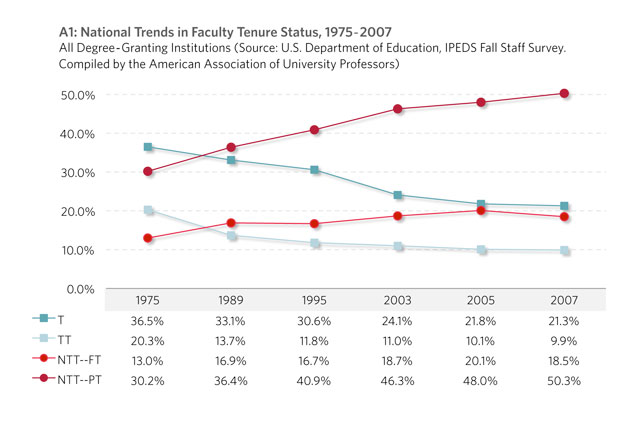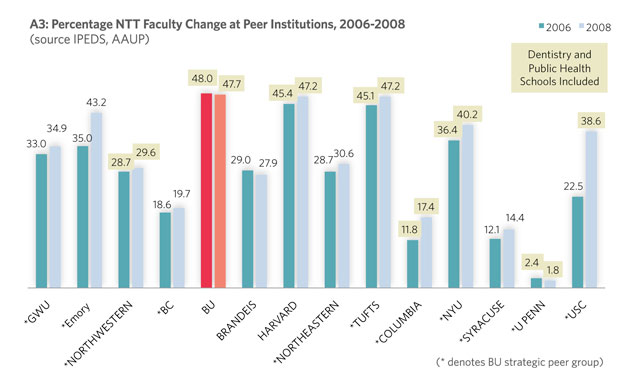4. Non-Tenure-Track Faculty in the National Discussion

For the last thirty years the share of tenured and tenure-track faculty positions has been declining, while the proportion of non-tenure-track appointments (both full-time and part-time) has continued to grow: In 2007 the number of non-tenure-track appointments nationally reached 68.8% (18.5% full-time and 50.3% part-time) of all faculty appointments, as compared to 43.2% in 1975 (13% full-time and 30.2% part-time). During the same period, tenure-track appointments decreased by half (9.9% in 2007 vs. 20.3% in 1975) and tenured positions decreased by a factor of 1.7 (21.3% in 2007 vs. 36.5% in 1975 (see A1, below). The reasons for and consequences of this shift from T/TT to NTT and part-time faculty are still not well understood. In a series of articles and reports, the AAUP raised concerns that NTT faculty lack institutional support and recognition and that NTT growth negatively impacts academic freedom, quality standards, and equity in compensation (AAUP [2003, 2006, 2008, 2009]). In 2006 the AAUP published the first Contingent(1) Faculty Index that provides data by tenure status for U.S. colleges and universities based on the Department of Education’s Integrated Postsecondary Education Data System (IPEDS).
Boston University’s faculty composition evinces the general shift toward NTT faculty. In 2007 66% of all faculty were on part-time or full-time NTT appointments (A2, below). This is less than 3% below the national percentage. However, there are two important differences from the national trends:
- While part-time appointments steadily increased nationally, BU’s part-time faculty decreased during 1989–2003 and then held steady in the 33%–36% range, remaining 15% below the national average.
- BU’s NTT faculty is almost equally split between full-time (31.4%) and part-time (34.6%), in contrast to about a 1:3 ratio of full-time to part-time faculty nationally (A2, below). This greater reliance on full-time rather than part-time NTT appointments is shared by most research universities. It indicates a more stable and better integrated NTT faculty, but does not eliminate differences in roles and perceptions between T/TT and NTT faculty.
The percentage of full-time NTT faculty for 2006 and 2008 at Boston University and a group of institutional peers is shown in A3, below. The data account for non-medical faculty but include faculty from schools of dentistry and public health that are typically on term appointments. Among the institutions that have dentistry and public health schools, Boston University, with 47.7% NTT appointments in 2008 and 48% in 2006, is comparable to Harvard (47.2% in 2008 and 45.4% in 2006) and Tufts (47.2% in 2008 and 45.1% in 2006), close to NYU (40.2% in 2008 and 36.4% in 2006), and substantially higher than Northwestern (29.6% in 2008 and 28.7% in 2006), Columbia (17.4% in 2008 and 11.8% in 2006), and U. Pennsylvania (1.8% in 2008 and 2.4% in 2006). These data are indicative of differences between institutions but are of limited use for a meaningful comparison for two main reasons: First, NTT faculty ranks, composition (teaching vs. research vs. clinical), and terms of appointments vary greatly among schools. Second, policies and procedures, both administrative and those relating to faculty governance, strongly affect the status and role of NTT faculty. A meaningful comparison requires detailed knowledge of the institutions as well as of their practices for handling NTT appointments.

All Degree-Granting Institutions (Source: U.S. Department of Education, IPEDS Fall Staff Survey. Compiled by the American Association of University Professors)

Note: These data do not include medical faculty, but include faculty from schools of dentistry and public health. The 48%/47.7% for full-time NTT at BU is comprised of 39.1% on the Charles River Campus and 100% at the SDM and SPH.
What is undeniable is that NTT faculty play an important role in teaching and research across the spectrum of higher education. The significance of this role and its implications for the academic profession and for higher education in general have been discussed in a broad range of venues, including the mass media, professional societies, legislative bodies, research conferences, and faculty and administrative forums. A few systematic research studies have been undertaken on the effects of NTT growth, most conducted in the last five years. We summarize the main results below.
The increase in NTT faculty has often been explained almost exclusively in economic terms, blaming university administrations for willful cost cutting and exploitation of “contingent faculty.” In reality, the causes are much more complex and are based on changes in economic structure and in educational and research requirements, and on the efforts of the university to adapt to rising demands and diminishing funding. Recent research has identified several drivers for the growth of NTT faculty (Ehrenberg [2005], Zhang and Ehrenberg [2006], Cross and Goldenberg [2009]):
- Growing importance and cost of science and engineering research. Despite increases in external funding, the cost for research is being borne predominantly by the academic institution.
- Faculty Compensation Differential. The increased demand for research faculty exceeds demand for teaching faculty and has resulted in a positive salary differential between research and teaching faculty. The commercialization of research funding in science and engineering provides additional income sources and intensifies the competition for top research faculty. Hiring NTT faculty thus becomes an attractive alternative for meeting teaching needs and realizing cost savings.
- Elimination of mandatory retirement age for tenured faculty in 1994. The stock market declines in 2000 and 2008 may lead to postponed retirement and impose higher costs and lower hiring rates.
- University efforts to retain faculty who are outstanding teachers, but have less interest in research.
The changing trends in faculty composition point to rapid transformation in three main areas of the academic profession (Schuster and Finkelstein [2006-a, b]; AAUP [2003–2009], Ehrenberg, Zhang [2005])—faculty appointments, academic work, and the institutional system of higher education.
- Faculty appointments show:
- Greater stratification: In addition to traditional T/TT appointments, a variety of NTT ranks and titles have become established.
- More flexible and efficient staffing, made possible by part-time and fixed-term, sometimes nonrenewable appointments.
- Academic work is affected in such ways as these:
- Opportunities for a traditional academic career have become more limited with the increased separation between research and teaching.
- The ability to respond to new trends and develop new curricula/programs has been enhanced through the hiring of NTT faculty.
- Diminished protection of academic freedom as contract faculty may be less inclined to explore controversial topics than tenured faculty.
- The institutional system of higher education is also altered: the hiring of NTT faculty leads to:
- Greater financial flexibility to adjust to changing enrollments
- Increased ability to respond to industry and market demands for new programs/curricula
- Enhanced ability to attract external funding. A study by Zhang and Ehrenberg [2006] suggests that increased usage of NTT faculty boosts external funding, presumably because of reduced teaching loads of T/TT faculty and creating more time for research.
- Corporatization of the faculty, in that the nature of NTT employment is more akin to that of managed professionals rather than to that of tenured academics.
Increases in NTT (both part-time and full-time) may negatively affect undergraduate retention rates (Ehrenberg, Zhang [2005b], Bettinger and Long [2006], Jaeger [2008])—the authors conjecture that this is because NTT are less institutionally connected and thus less cognizant of student opportunities and the curricula of different programs at the academic institution.
Most recently Cross and Goldenberg [2009] published a study that addresses NTT issues at elite research universities. The study is based on the analysis of data, policy documents, and interviews with administrators and faculty at ten universities: five public (University of California at Berkeley, University of Illinois, University of Michigan, University of Virginia, University of Washington), four private (Duke University, MIT, Northwestern University, Washington University), and one mixed private-public (Cornell University). The issues faced by these institutions are similar to those at Boston University. Cross and Goldenberg’s work differs from previous publications in two important aspects: (i) Faculty composition is analyzed in the context of institutional policies and practices and not exclusively through aggregated statistical data (even when the data are collected from similar institutions, differences in the use of faculty titles, hiring and evaluation practices can make them unreliable for meaningful comparisons); (ii) The legitimate and sometimes competing interests of the three major constituents—the faculty, administration, and the institution—are presented in relation to the reality of university administration and faculty governance.
Recognizing the importance of the issues related to the growing number and role of NTT faculty, several universities appointed committees to analyze the status of NTT faculty at their institutions and develop appropriate policies. The Task Force reviewed reports and policies on NTT faculty at Brandeis, Brown, Cornell, Columbia, Duke, Tufts, Rutgers, Rochester, Yale, NYU, the University of Michigan, and University of Pennsylvania. Our review of these existing policies and reports has guided our efforts to determine the best practices for Boston University, to clarify the rights and responsibilities of our NTT faculty, and to identify how they differ from those of tenure and tenure-track appointments.
1. The AAUP term “contingent” refers to part-time and full-time non-tenure-track appointments. We prefer and use the term non-tenure-track faculty in this report.

